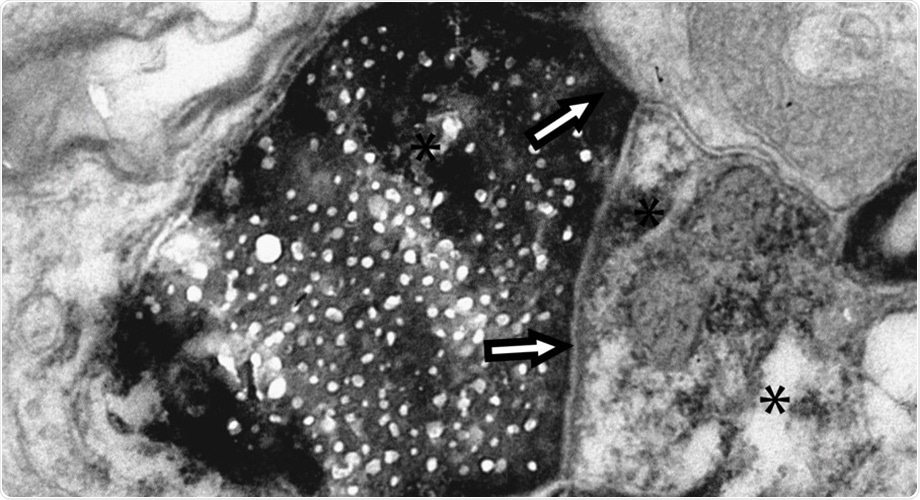Scientists from Scripps Research Institute discovered hundreds of proteins that are constantly transferred throughout the healthy brain in small membrane-enclosed sacs, revealing a novel mode of communication among brain cells. The findings could help researchers understand neurological conditions such as Alzheimer’s and autism. The study was published in the journal Cell Reports.

Scripps Research scientists tracked proteins tagged with biotin (black areas of this electron microscopy image) from retinal cells (pictured) to the visual cortex of the brain. Image Credit: The Scripps Research Institute
This is an entirely new way that cells in the brain can communicate with one another that has never before been integrated into how we think about health and disease. It opens up a lot of exciting avenues of research.”
Hollis Cline PhD, Hahn Professor, Neuroscience, Scripps Research Institute
Neurotransmitters are chemicals, which transport signals from one cell to the next, are typically used by neurons to transmit signals throughout the brain. Hormones also distribute through the brain, influencing cell growth and aiding in the formation of new neural connections.
Earlier, researchers presumed that a tiny proportion of proteins moved around the brain more autonomously in isolated cases. For example, research examining Alzheimer’s disease discovered that synuclein and tau—two proteins linked to neurodegeneration—could move between brain cells of the Alzheimer-affected animals.
However, they were unsure whether this was related to the disease itself. Other teams have presented proof that a protein from one cell can be located in another; however, they were unable to rule out the possibility that the protein was parted into its amino acid building blocks and then reattached in the destination cell.
Cline and her coworkers used a method of labeling proteins in the new study that made sure they only tracked proteins that remained intact. If the proteins are disassembled, the tag, a biotin molecule, cannot be reincorporated into new proteins.
The tag was implanted in the retinal ganglion cells of rats’ eyes by the research team. After eleven days, they analyzed the cells from the visual cortex—a part of the brain that processes sight and is physically separate from the retinal ganglion cells.
Cline’s team then isolated any biotin-tagged proteins in the visual cortex. They discovered over 200 proteins and used mass spectrometry to recognize each one with the help of Scripps Research professor John Yates III, PhD.
Previous methods didn’t allow researchers to identify specific proteins being transported or watch the process at an ultra-structural level. So, using this new combination of protein tagging and identification strategies allowed us to make headway in really understanding what was happening with these proteins.”
Lucio Schiapparelli, Study First Author and Former Staff Scientist, Scripps Research Institute
Many of the proteins involved have known functions in the brain, such as tau and synuclein, which are seen progressing between cells in Alzheimer’s disease.
This is a confirmation that in the healthy brain, tau and synuclein—and their movement around the brain—is normal. But with Alzheimer’s disease it’s a toxic form of the protein that is transported between neurons.”
Hollis Cline PhD, Hahn Professor, Neuroscience, Scripps Research Institute
The scientists also used a unique set of protein tags to prove that these proteins were all being transferred between cells in the majority of cases within exosomes—tiny, membrane-enclosed compartments packed with proteins, similar to suitcases stuffed with clothes.
This observation can help other scientists who want to track protein movements in other areas of the brain and correlate inter-neuronal protein transport in healthy versus diseased brains. Despite the fact that the new research was done in the visual system, Cline believes the results are still far-reaching.
“There are likely proteins being shuttled around in this mechanism all throughout the brain. What I really hope is that this spurs new interest in exploring the roles of intercellular communication that we had not known about until now,” concludes Cline.
Source:
Journal reference:
Schiapparelli, L. M., et al. (2022) Proteomic screen reveals diverse protein transport between connected neurons in the visual system. Cell Reports. doi.org/10.1016/j.celrep.2021.110287.